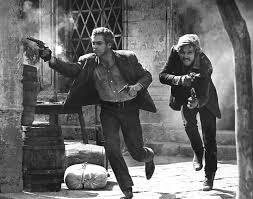Choreographing a Fight Scene
The first movie I ever got sole writing credit on was one of the worst pictures ever made. I’m not kidding. I won’t even tell you the title because if I do you’ll lose all respect for me.

Paul Newman and Robert Redford in “Butch Cassidy and the Sundance Kid.” No, this is not the movie I’m talking about. But this shoot-out DOES illustrate the principle.
But …
But I learned one enormous lesson on that movie.
We were shooting a gunfight scene. The scene took place in a warehouse. It involved the hero and his girlfriend and about a dozen bad guys. Dudes were dropping from the rafters, plunging through skylights; cars were blowing up, the warehouse was going up in flames, not to mention gunfire was ripping in all directions, coming from half a dozen different kinds of weapons—.45s, nine-millimeters, shotguns, machine guns.
In the script, all it said was “X shoots it out with a dozen bad guys.”
But in actually filming the scene, the stunt coordinator and the Second Unit director had to block out and choreograph every gunshot, every fall, every explosion, every vehicle crash. It was an amazingly complicated operation, with absolutely nothing left to chance.
Here’s what the Second Unit director told me:
Any time you film a guy firing a gun, you MUST also film where the bullet hits and what effect it produces. Otherwise the scene becomes totally confusing to the audience. And it looks fake.
I had never thought about that before. But I could see at once that the director was absolutely right.
I thought about fist fight scenes, even sword fights. Don’t you hate it when one guy slashes with a samurai sword and you don’t see where the blade goes or what it hits? Or those horrible fakey kung-fu fights that just look like a blur of kicks and punches and you can’t tell who’s winning or losing?
I thought about dance scenes. How bogus is it when you see the star start to do a pirouette or a flip and then the camera cuts to someone who’s obviously a stunt double doing the move, then they cut back to the star (close up of course, so you can’t see her body in motion) as if she had just performed the move herself.
Bad.
Bad!
I thought about the great old Fred Astaire-Ginger Rogers movies (or Fred with Cyd Charisse or Eleanor Powell or Rita Hayworth, or Fred with anybody) and how not only does the camera never show anything but both dancers head-to-toe, but it never cuts away. Every scene is shot in one take, so you know there’s no cheating. This is Fred. This is Ginger. They really did it, and with no tricks.
The same principle applies, of course, to any setup and payoff in any story. The old saw that says
If you show a gun in any scene, that gun has to be fired in some subsequent scene
could not be more true.
If the gun is not going to be fired in the story, don’t show it at all.
If you start any narrative thread anywhere in the story, that thread has to be paid off later. Otherwise don’t start it.
I remember watching the final cut-together version of the shoot-out in the warehouse. Forget that the movie was terrible. The scene played great.
One Bad Guy pops up from behind a barrel and fires a shot; we see the bullet strike and shatter the windshield of the car the hero and his girl are hiding behind—and we see them react as the glass blasts all over them. Next a villain plunges through the skylight firing a machine gun. Rat-a-tat: a row of bullet strikes is stitched along the wall, just missing hero and girl as they flee.
The scene looked absolutely real and made complete sense. You could follow what was happening. The action looked authentic and convincing.
The director’s axiom worked.
When you fire a gun (or throw a punch or open a narrative thread), make sure the audience sees where it lands and what effect it produces.
Otherwise the scene looks confusing and fake. It looks like a cheat.



